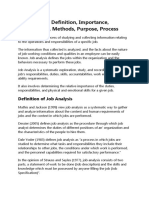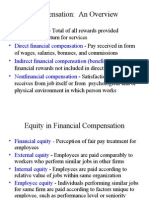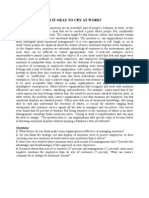Job Evaluation
Job Evaluation
Uploaded by
Shanna MillsCopyright:
Available Formats
Job Evaluation
Job Evaluation
Uploaded by
Shanna MillsCopyright
Available Formats
Share this document
Did you find this document useful?
Is this content inappropriate?
Copyright:
Available Formats
Job Evaluation
Job Evaluation
Uploaded by
Shanna MillsCopyright:
Available Formats
Job evaluation means systematically determining relative worth of jobs to create job structure.
An attempt to identify inputs that are most valuable to the organization & to develop job hierarchy based on which jobs have more or less of those dimensions Job Evaluation Methods: The essence of compensation administration is job evaluation and the establishment of the pay structure. Lets now turn our attention to the topic of job evaluation. By job evaluation we mean using the information in job analysis to systematically determine the value of each job in relation to all jobs with in the organization. In short, job evaluation seeks to rank all the jobs in the organization and place them in a hierarchy that will reflect the relative worth of each. There are four general job evaluation methods. a. Ranking method: Raters examine the description of each job being evaluated and arrange the jobs in order according to their value to the company. This method requires a committee typically composed of both management and employee representative to arrange job in a simple rank order from highest to lowest. No attempts are made to break down the jobs by specific weighted criteria. The committee members merely compare two jobs and judge which one is more important, or more difficult to perform. Then they compare the other job with the first two, and so on until all the jobs have been evaluated and ranked. The most obvious limitation to the ranking method is its sheer inability to be managed when there are a large number of jobs. Other drawbacks to be considered are the subjectivity of the method- there are no definite or consistent standards by which to justify the rankings- and the fact that because jobs are only ranked in terms of order, we have no knowledge of the distance between the ranks. b. Classification method: A job evaluation method by which a number of classes or grades are defined to describe a group of jobs is known as Classification method. The classifications are created by identifying some
common denominator skills, knowledge, responsibilities with the desired goal being the criterion of a number of distinct classes or grades of jobs. Once the classifications are established, they are ranked in an overall order of importance according to the criteria chosen, and each job is placed in its appropriate classification. This later action is generally done by comparing each positions job description against the classification description and benchmarked jobs. The classification method shares most of the disadvantages of the ranking approach, plus the difficulty of writing classification descriptions, judging which jobs go where, and dealing with jobs that appear to fall into more than one classification. c. Factor comparison method: Raters need not keep the entire job in mind as they evaluate; instead, they make decisions on separate aspects, or factors, of the job. A basic underlying assumption is that there are five universal job factors: (1) Mental Requirements, (2) Skills, (3) Physical Requirements, (4) Responsibilities, and (5) Working Conditions. The committee first rank each of the selected benchmark jobs on the relative degree of difficulty for each of the five factors. Then, the committee allocates the total pay rates for each job to each factor based on the importance of the respective factor to the job. A job comparison scale, reflecting rankings and money allocations, is developed next. The raters compare each job, factor by factor, with those appearing on the job comparison scale. Then, they place the jobs on the chart in an appropriate position. d. Point method: Raters assign numerical values to specific job components, and the sum of these values provides a quantitative assessment of a jobs relative worth. The point method requires selection of job factors according to the nature of the specific group of jobs being evaluated. After determining the group of jobs to be studied, analysts conduct job analysis and write job descriptions. Next, the analysts select and define the factors to be used in measuring job value and which become the standards used for the evaluation of jobs. Education, experience, job knowledge, mental effort, physical effort, responsibility, and working conditions are examples of factors typically used. The committee establishes factor weights according to their relative importance in the jobs being evaluated, and then determines the total number of points to be used in the plan. A
distribution of the point values to job factor degrees is made, with the next step being the preparation of a job evaluation manual. Hay guide chart-profile method: A highly refined version of the point method that uses the factors of know-how, problem solving, accountability, and, where appropriate, working conditions.
What is job evaluation? what are the different ways in which a job evaluation can be carried out? Job evaluation is a systematic assessment of job content. It establishes the worth of a job in terms of salary or wage compared to other jobs. Many elaborate schemes have been developed and applied with varying degrees of success. While some structure is necessary on a project, pay is more likely to be governed by market conditions, scarcity, individual knowledge, performance or trade agreements. Job evaluation is the method of ordering jobs or positions with respect to their value or worth to the organization, and placing them into job families and zones. Job evaluation is the A formal process by which management creates a job worth hierarchy within an organization. The two basic approaches are the market data approach and the job content approach. The different ways in which a job evaluation can be carried out is i) Ranking - This method is one of the simplest to administer. Jobs are compared to each other based on the overall worth of the job to the organization. The 'worth' of a job is usually based on judgements of skill, effort (physical and mental), responsibility (supervisory and fiscal), and working conditions. Advantages : * Simple. * Very effective when there are relatively few jobs to be evaluated (less than 30). Disadvantages : * Difficult to administer as the number of jobs increases. * Rank judgements are subjective. * Since there is no standard used for comparison, new jobs would have to be compared with the existing jobs to determine its appropriate rank. In essence, the ranking process would have to be repeated each time a new job is added to the organization. Ranking Methods * Ordering Simply place job titles on 3x5 inch index cards then order the titles by relative importance to the organization.
* Weighting * Paired Comparison ii) Classification - Jobs are classified into an existing grade/category structure or hierarchy. Each level in the grade/category structure has a description and associated job titles. Each job is assigned to the grade/category providing the closest match to the job. The classification of a position is decided by comparing the whole job with the appropriate job grading standard. To ensure equity in job grading and wage rates, a common set of job grading standards and instructions are used. Because of differences in duties, skills and knowledge, and other aspects of trades and labor jobs, job grading standards are developed mainly along occupational lines. The standards do not attempt to describe every work assignment of each position in the occupation covered. The standards identify and describe those key characteristics of occupations which are significant for distinguishing different levels of work. They define these key characteristics in such a way as to provide a basis for assigning the appropriate grade level to all positions in the occupation to which the standards apply. Advantages * Simple. * The grade/category structure exists independent of the jobs. Therefore, new jobs can be classified more easily than the Ranking Method. Disadvantages * Classification judgments are subjective. * The standard used for comparison (the grade/category structure) may have built in biases that would affect certain groups of employees (females or minorities). * Some jobs may appear to fit within more than one grade/category. iii)Factor Comparison - A set of compensable factors are identified as determining the worth of jobs. Typically the number of compensable factors is small (4 or 5). Examples of compensable factors are: o Skill o Responsibilities o Effort o Working Conditions Next, benchmark jobs are identified. Benchmark jobs should be selected as having certain characteristics. o equitable pay (not overpaid or underpaid) o range of the factors (for each factor, some jobs would be at the low end of the factor while others would be at the high end of the factor). This process establishes the rate of pay for each factor for each benchmark job. Slight adjustments may need o be made to the matrix to ensure equitable dollar weighting of the factors. The other jobs in the organization are then compared with the benchmark jobs and rates of pay for each factor are summed to determine the rates of pay for each of the other jobs. Advantages o The value of the job is expressed in monetary terms. o Can be applied to a wide range of jobs. o Can be applied to newly created jobs. Disadvantages o The pay for each factor is based on judgements that are subjective.
o The standard used for determining the pay for each factor may have build in biases that would affect certain groups of employees (females or minorities). iv) Point Method - A set of compensable factors are identified as determining the worth of jobs. Typically the compensable factors include the major categories of: * Skill * Responsibilities * Effort * Working Conditions These factors can then be further defined. * Skill * Experience * Education * Ability * Responsibilities * Fiscal * Supervisory * Effort * Mental * Physical * Working Conditions * Location * Hazards * Extremes in Environment The point method is an extension of the factor comparison method. Each factor is then divided into levels or degrees which are then assigned points. Each job is rated using the job evaluation instrument. The points for each factor are summed to form a total point score for the job. Jobs are then grouped by total point scores and assigned to wage/salary grades so that similarly rated jobs would be placed in the same wage/salary grade. Advantages + The value of the job is expressed in monetary terms. + Can be applied to a wide range of jobs. + Can be applied to newly created jobs. Disadvantages + The pay for each factor is based on judgements that are subjective. + The standard used for determining the pay for each factor may have build in biases that would affect certain groups of employees (females or minorities).
You might also like
- Yurchenko, Misha - The STAR Interview - How To Tell A Great Story, Nail The Interview and Land Your Dream Job (2017)Document153 pagesYurchenko, Misha - The STAR Interview - How To Tell A Great Story, Nail The Interview and Land Your Dream Job (2017)masterholmes100% (2)
- Work in Romania Full VersionDocument2 pagesWork in Romania Full VersionFarhad Ali100% (1)
- HRM Job EvaluationDocument13 pagesHRM Job EvaluationVickey Verma0% (1)
- Chapter 9Document14 pagesChapter 9ranne18No ratings yet
- Job Evaluation ManualDocument12 pagesJob Evaluation Manualrendra_permana4585No ratings yet
- Job EvaluationDocument23 pagesJob EvaluationPoorna ChelvanNo ratings yet
- Job Evaluation MethodsDocument3 pagesJob Evaluation Methodsgurudeep25No ratings yet
- Job EvaluationDocument16 pagesJob EvaluationSangeetha Sasidharan50% (2)
- Study Notes On Job EvaluationDocument8 pagesStudy Notes On Job Evaluationkomal100% (1)
- Features of Job EvaluationDocument11 pagesFeatures of Job EvaluationSana KhanNo ratings yet
- Job EvaluationDocument15 pagesJob EvaluationShahrin AfrozNo ratings yet
- Job Evaluation Is A Process of Finding Out The Relative Worth of A Job As Compared To Other JobsDocument5 pagesJob Evaluation Is A Process of Finding Out The Relative Worth of A Job As Compared To Other JobsfaiziaaaNo ratings yet
- Job EvaluationDocument10 pagesJob Evaluationsimply_coool100% (2)
- Compensation Establishing Strategic Pay PlansDocument46 pagesCompensation Establishing Strategic Pay PlansSunil SinghNo ratings yet
- Unit V - WAGES AND INCENTIVES - 09 - 03 - 2015 PDFDocument41 pagesUnit V - WAGES AND INCENTIVES - 09 - 03 - 2015 PDFNitin NischalNo ratings yet
- Compensation SlidesDocument48 pagesCompensation SlidesGaurav GopalNo ratings yet
- What Are Market Pricing and Job EvaluationDocument8 pagesWhat Are Market Pricing and Job EvaluationFaribaTabassumNo ratings yet
- Pay For Performance AND Financial Incentives: By: Farhan Khalid (18) AmanDocument20 pagesPay For Performance AND Financial Incentives: By: Farhan Khalid (18) AmanFarhan KhalidNo ratings yet
- Job Evaluation AssignmentDocument4 pagesJob Evaluation AssignmentRichard DeniranNo ratings yet
- Job Analysis - Models and Other InfoDocument23 pagesJob Analysis - Models and Other InfoharidhraNo ratings yet
- Job Evaluation MethodsDocument3 pagesJob Evaluation MethodsHK MahmudNo ratings yet
- Purpose of Job AnalysisDocument2 pagesPurpose of Job AnalysisFrank UrassaNo ratings yet
- Session 15,16,17 - Managing CompensationDocument50 pagesSession 15,16,17 - Managing CompensationJimit ShahNo ratings yet
- Performance ManagementDocument50 pagesPerformance ManagementVasanthi Donthi100% (2)
- Job EvaluationDocument10 pagesJob EvaluationRaglin NadarNo ratings yet
- Compensation: Amity Business SchoolDocument35 pagesCompensation: Amity Business SchoolIshita KunduNo ratings yet
- Job Analysis: Job Analysis Is The Process of Collecting Job Related InformationDocument49 pagesJob Analysis: Job Analysis Is The Process of Collecting Job Related InformationBhasker JorwalNo ratings yet
- Job EvaluationDocument28 pagesJob Evaluationld_ganeshNo ratings yet
- Chapter 11: Strategic Pay PlansDocument8 pagesChapter 11: Strategic Pay PlansHam XaNo ratings yet
- Job Analysis (Chap 3)Document24 pagesJob Analysis (Chap 3)NehaAsif100% (1)
- Factors Affecting Job DesignDocument12 pagesFactors Affecting Job DesignUmi DuqueNo ratings yet
- Benefits of Job Analysis Business EssayDocument14 pagesBenefits of Job Analysis Business Essayfoin clarisseNo ratings yet
- Job EvaluationDocument18 pagesJob EvaluationAbhijaat SahuNo ratings yet
- Chapter 2serdtfyguhipDocument30 pagesChapter 2serdtfyguhipMuchtar ZarkasyiNo ratings yet
- Job Analysis Is A Process of Gathering Information About The JobDocument2 pagesJob Analysis Is A Process of Gathering Information About The Joblitrakhan100% (1)
- COMPENSATION 1 - Pay Plans - Basic IssuesDocument48 pagesCOMPENSATION 1 - Pay Plans - Basic IssuesArefin Wisea AblagNo ratings yet
- Continuum of Compensation Philosophies: Figure 12-3Document29 pagesContinuum of Compensation Philosophies: Figure 12-3madanNo ratings yet
- Compensation Managementat ABC TravelsDocument37 pagesCompensation Managementat ABC TravelsNishala AbeywickramaNo ratings yet
- Methods of Job EvaluationDocument20 pagesMethods of Job EvaluationKim Joaquin100% (1)
- Session 4 Traditional Basis For PayDocument76 pagesSession 4 Traditional Basis For PayUmer Farooq100% (1)
- Compensations Benefits Notes PDFDocument74 pagesCompensations Benefits Notes PDFmanjit tewaryNo ratings yet
- Compensation ManagementDocument19 pagesCompensation ManagementRanjith PrakashNo ratings yet
- Attitudes and Job Satisfaction and The Relation With Organizational BehaviorDocument9 pagesAttitudes and Job Satisfaction and The Relation With Organizational BehaviorMohamed HalabiNo ratings yet
- Demand and Supply ForecastingDocument19 pagesDemand and Supply ForecastingRavi VermaNo ratings yet
- The Effect of Career Development and Job Satisfaction On The Commitment of Employee Organizations of Pt. Tatamulia Nusantara IndahDocument7 pagesThe Effect of Career Development and Job Satisfaction On The Commitment of Employee Organizations of Pt. Tatamulia Nusantara IndahInternational Journal of Innovative Science and Research TechnologyNo ratings yet
- Direct Compensation-Human Resource Management by Wayne MondyDocument11 pagesDirect Compensation-Human Resource Management by Wayne MondyMaqsood BrohiNo ratings yet
- Ch#01 CompensationDocument19 pagesCh#01 CompensationAnum AhmadNo ratings yet
- Unit 9: Job Evaluation: StructureDocument11 pagesUnit 9: Job Evaluation: StructurerahulparasarNo ratings yet
- Human Resource ManagementDocument32 pagesHuman Resource ManagementKhadarNo ratings yet
- Pay For PerformanceDocument15 pagesPay For PerformancePREJA PATELNo ratings yet
- Chapter 2 Strategic PerspectivesDocument9 pagesChapter 2 Strategic PerspectivesNeeti Saxena100% (1)
- HR ScorecardDocument14 pagesHR Scorecard26543710% (1)
- A Case Study of Performance Appraisal in A SMEDocument5 pagesA Case Study of Performance Appraisal in A SMEImran ZulfiqarNo ratings yet
- Factors Influencing Employee Compensation & How To DeviseDocument9 pagesFactors Influencing Employee Compensation & How To DevisesangeethaNo ratings yet
- HRM 7 - CompensationDocument30 pagesHRM 7 - CompensationSonal Khurana100% (1)
- Transfer and Promotion: Presented By:-Sonu Hotwani Kitty Singla Shweta UpadhyayDocument28 pagesTransfer and Promotion: Presented By:-Sonu Hotwani Kitty Singla Shweta UpadhyaySonu HotwaniNo ratings yet
- Managing OD ProcessDocument54 pagesManaging OD ProcessSf I-cheok100% (1)
- Is It Okay To Cry at WorkDocument1 pageIs It Okay To Cry at WorkFaizan Ahmed Kiyani100% (2)
- Module 3 Organizational Structure, Job Description and Job EvaluationDocument21 pagesModule 3 Organizational Structure, Job Description and Job EvaluationJasper Mina GerminoNo ratings yet
- Unit 2 Introduction To Compensation BenefitsDocument27 pagesUnit 2 Introduction To Compensation BenefitsKazia Shamoon AhmedNo ratings yet
- Performance Appraisal Assessment A Clear and Concise ReferenceFrom EverandPerformance Appraisal Assessment A Clear and Concise ReferenceNo ratings yet
- Tuton Sesi 5 Bahasa Inggris Niaga: Diskusi 5Document2 pagesTuton Sesi 5 Bahasa Inggris Niaga: Diskusi 5AriefNo ratings yet
- PPM (Unit-5)Document47 pagesPPM (Unit-5)Nitin vermaNo ratings yet
- Working Family PaymentDocument12 pagesWorking Family PaymentGordonPhillipsNo ratings yet
- National Irrigation Administration: Republika NG Pilipinas (Pambansang Pangasiwaan NG Patubig)Document1 pageNational Irrigation Administration: Republika NG Pilipinas (Pambansang Pangasiwaan NG Patubig)TZ Apale ArceteNo ratings yet
- Santiago Lopez Garcia Eid 101678632Document57 pagesSantiago Lopez Garcia Eid 101678632Santiago LopezNo ratings yet
- Literature Review On OvertimeDocument8 pagesLiterature Review On Overtimeea4c954q100% (1)
- Sunripe Vs CIRDocument2 pagesSunripe Vs CIRRobert QuiambaoNo ratings yet
- 09 Tiangco v. ABS-CBNDocument2 pages09 Tiangco v. ABS-CBNJelaineNo ratings yet
- Msunduzi Application Form.Document5 pagesMsunduzi Application Form.SiyabongaNo ratings yet
- Guideline For Calculating Hourly RateDocument4 pagesGuideline For Calculating Hourly RatemallinathpnNo ratings yet
- Curriculum ViteaDocument7 pagesCurriculum ViteabissauNo ratings yet
- Appointment Letter For Existing Employees - StaffDocument2 pagesAppointment Letter For Existing Employees - StaffPrashant ZambreNo ratings yet
- Hiring Without FiringDocument9 pagesHiring Without FiringPrateek BaliyaNo ratings yet
- High Speed Two (HS2) : Costs and BenefitsDocument13 pagesHigh Speed Two (HS2) : Costs and BenefitsKamran MalikNo ratings yet
- Indonesia Talent Trends 2021 Report 42036Document51 pagesIndonesia Talent Trends 2021 Report 42036Efriyanti LameinaNo ratings yet
- LabRel Midterm Exam Reviewer (Atty. Usita) - SBCDocument10 pagesLabRel Midterm Exam Reviewer (Atty. Usita) - SBCVicson MabangloNo ratings yet
- Philsa International Placement and Services Corp Vs Sec of LaborDocument1 pagePhilsa International Placement and Services Corp Vs Sec of LaborAlyanna BarreNo ratings yet
- Hazardous Occupations Rules 2Document5 pagesHazardous Occupations Rules 2Rana Samee KhalidNo ratings yet
- A Presentation On The Occupational Safety, Health and Working Conditions Code, 2020 - ImportantDocument12 pagesA Presentation On The Occupational Safety, Health and Working Conditions Code, 2020 - Importantkavyashreemb100% (1)
- Toxic Culture Triggers Turnover Cost BillionsDocument2 pagesToxic Culture Triggers Turnover Cost BillionsArlene MaldoNo ratings yet
- Leave Application FormDocument5 pagesLeave Application FormtalhaNo ratings yet
- Assimilating Generation Y IT Hires Into USAA's WorkforceDocument14 pagesAssimilating Generation Y IT Hires Into USAA's WorkforceSteve PanNo ratings yet
- Larry Page and Review of His LeadershipDocument7 pagesLarry Page and Review of His LeadershipNibrazKhaldaNo ratings yet
- Chapter 2 - Strategic HRMDocument18 pagesChapter 2 - Strategic HRMafityzolaNo ratings yet
- I Want To Work in Uk As A Doctor 1Document13 pagesI Want To Work in Uk As A Doctor 1Hassan Musadaq HamzahNo ratings yet
- Cheat Sheet - Australian Immigration Requirement For Skill SelectDocument15 pagesCheat Sheet - Australian Immigration Requirement For Skill SelectManjunath0% (1)
- PUPUN00342240000080825 NewDocument12 pagesPUPUN00342240000080825 Newsachin kambojNo ratings yet
- Silon Construction and Engineering LTD 44 London Street, Reading, RG1 4SQ, UNITED Kingdom Tel: +44 2032895228 /fax: +44 2032895228Document2 pagesSilon Construction and Engineering LTD 44 London Street, Reading, RG1 4SQ, UNITED Kingdom Tel: +44 2032895228 /fax: +44 2032895228Jelena V.No ratings yet

























































































